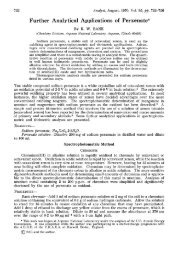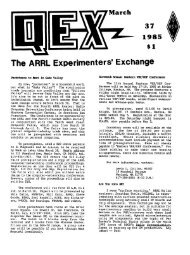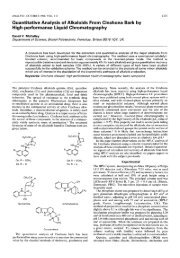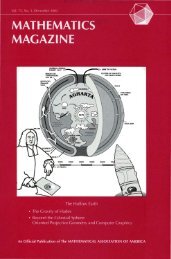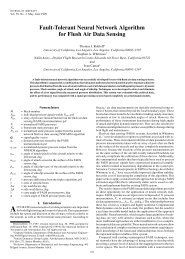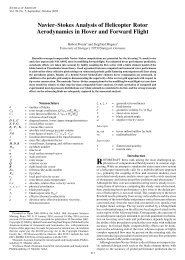pdf 6436KB Sep 25 2010 04
pdf 6436KB Sep 25 2010 04
pdf 6436KB Sep 25 2010 04
- TAGS
- 81.70.242.211
You also want an ePaper? Increase the reach of your titles
YUMPU automatically turns print PDFs into web optimized ePapers that Google loves.
others offer custom cables to connect<br />
their decoders, keyers and controllers.<br />
MicroHAM’s multi-device Router software<br />
provides explicit support for the K3.<br />
The logging programs WinTest, N1MM<br />
Logger, DX4WIN, Winlog 32, Logger32,<br />
DXLab, WriteLog and MacLogger DX all<br />
recognize the K3, as do the rig-control<br />
programs Ham Radio Deluxe, N4PY,<br />
N3FJP, TRX-Manager and DXLab. Rose<br />
Kopp, N7HKW, makes custom rig covers<br />
and carrying cases. Nifty Accessories<br />
publishes a laminated, spiral-bound,<br />
quick-reference guide.<br />
Lab Tests and Reviews<br />
Press reviews of the K3 have been quite<br />
favorable:<br />
♦ Performance guru Rob Sherwood,<br />
NCØB, published his measurements of the<br />
K3 in February 2008, and it topped the 75+<br />
rigs on his “Receiver Test Data” chart (see<br />
www.sherweng.com/table.html). Rob<br />
measured a minimum noise fl oor of –138<br />
dBm, two-tone third-order IMD dynamic<br />
range of 95 to 101 dB at 2 kHz spacing<br />
and blocking dynamic range of 140 dB at<br />
100 kHz spacing. Rob is well known for his<br />
groundbreaking critiques of radios and the<br />
measurement techniques used to assess<br />
them. At Dayton in 2007 he focused on<br />
the poor transient response of most thencurrent<br />
DSP radios. Elecraft improved the<br />
K3 AGC to a level that Rob describes as<br />
“perfect” against his lab test that aggravates<br />
a receiver with nanosecond-range pulses. 1<br />
In 2008 he came down on intermodulation<br />
and harmonic distortion in RF power and<br />
audio amplifi ers. It will be interesting to see<br />
which vendors respond most quickly and<br />
effectively to his concerns.<br />
The ARRL review appeared in April<br />
2008 QST and is available to League<br />
members at www.arrl.org. It corroborates<br />
the Sherwood tests within a dB or<br />
so and notes 132 to 139 dB blocking gain<br />
compression, 98 dB fi rst IF rejection and<br />
109 dB image rejection on 20 meters. The<br />
review said, “Overall receiver performance<br />
is right up there with the best radios the<br />
Lab has ever measured, and this is the<br />
fi rst receiver we’ve tested with better than<br />
100 dB IMD dynamic range at the closer<br />
signal spacings.”<br />
In its review, the RSGB’s RadCom called<br />
the K3 “an impressive radio” and “one of the<br />
leading radios for close-in dynamic range<br />
and with excellent features.” The RadCom<br />
review judged the K3 “an ideal radio for use<br />
at home, Field Day or DXpeditions.”<br />
Dave Johnson, G4AON, has published<br />
an extensive online review with detailed<br />
product description, his own informal test<br />
results, photos and scope plots (www.<br />
astromag.co.uk/k3/).<br />
Operating Results and Feedback<br />
The K3 is almost becoming a cult radio.<br />
Perhaps the most visible endorsement was<br />
8 November/December 2008 NCJ<br />
the record-setting February 2008 VP6DX<br />
Ducie Island DXpedition, which used K3s<br />
exclusively to make 183,686 contacts. The<br />
VP6DX team reported, “The outstanding<br />
receiver and transmitter characteristics allow<br />
us to run two positions simultaneously<br />
on any band — even the very narrow 30<br />
meter band — with absolutely no interference.<br />
Good design makes the complex<br />
appear simple: the ins and outs of this<br />
sophisticated radio were quickly mastered<br />
by the operator team, none of whom had<br />
seen a K3 before the expedition.”<br />
At Field Day 2008, the K6NV 2A group<br />
(MLDXCC + Team Truckee) ran three K3s<br />
in a fi re lookout with no inter-station interference.<br />
Most participants were new to the<br />
K3 and had received little or no briefi ng.<br />
They enjoyed the rig from the start, but I<br />
did fi nd myself inserting hints from time to<br />
time to demonstrate features the others<br />
had not yet discovered.<br />
WØYK and AE6Y took three K3s to<br />
Aruba, where they joined W6LD and<br />
KX7M in a 4333-QSO multi-two operation<br />
in the 2008 CQ World Wide WPX CW as<br />
P4ØL. Although they had two radios and<br />
two operators at each position, they often<br />
had the second op listening on the main<br />
K3 sub-receiver for in-band mults. WØYK<br />
remarked that conditions were poor.<br />
“Most of the time signals were right at<br />
the noise level, and the superiority of the<br />
ComTek<br />
Systems<br />
NEW!<br />
2 el. Vertical Switch<br />
Secure Online<br />
Ordering<br />
PVS-2 for 2 el. Vertical Specify band<br />
Offers selectable end fire or broadside directions<br />
STACK - 2 for tribanders 80-10<br />
SYS-3 STACK YAGI SWITCH<br />
RCAS-8 REMOTE ANTENNA SWITCH<br />
VFA-4 Set of 4 vertical feedpoint assemblies<br />
RR-4 Aluminum 60 hole Radial Rings<br />
COMTEK THE 4-SQUARE EXPERTS<br />
ACB-160 ACB-80<br />
ACB-40 ACB-20<br />
ACB-15 ACB-10<br />
CALL FOR PRICES<br />
ComTek Systems<br />
P.O. Box 470565, Charlotte, NC 28247<br />
Tel: (7<strong>04</strong>) 542-4808 FAX (7<strong>04</strong>) 542-9652<br />
e-mail - info@comteksystems.com<br />
Web: http://www.comteksystems.com<br />
K3 receiver really made a difference in<br />
letting us make at least some contacts,”<br />
he said afterward. “Two of our four operators<br />
had never used a K3. Not long into<br />
the contest, most of us avoided using the<br />
PROII because the K3 was so much more<br />
pleasant to listen with.”<br />
WØYK went on to say, “The exceptional<br />
dual receive in the K3 provides outstanding<br />
ability to simultaneously run and<br />
search and pounce the same band.” He<br />
judged the enhanced radio “a joy to use<br />
with negligible learning curve.”<br />
The P4ØL gang used some external<br />
audio switching to achieve a high level of<br />
operator coordination and station fl exibility.<br />
Operators said they also look forward<br />
to planned ability to use the main and<br />
sub-receivers on different bands. They<br />
complained that some front-panel controls<br />
are still locked out while transmitting. This<br />
situation has been improving since fi eld<br />
testing, however.<br />
N5RZ, K5OT and K5TR teamed up for<br />
the 2008 ARRL June VHF QSO Party<br />
using a K3 as the 6 meter radio. They<br />
made 1392 QSOs on 6 meters, noting<br />
that the K3 performed well. They forecast<br />
increased 6 meter contest activity, thanks<br />
to the emerging trend of top-level contest<br />
rigs to include 6 meter capability.<br />
What’s Left?<br />
The “to-do” list at Elecraft remains long,<br />
even though the K3 is now almost feature<br />
complete with respect to its original specifi<br />
cation. It seems so easy to add features<br />
through fi rmware that requests for refi nement<br />
never cease, and Elecraft listens very<br />
well. Some planned additions include:<br />
♦ digital modes other than FSK, AFSK<br />
and PSK 31 2<br />
♦ a band-display panadapter 3<br />
♦ variable-bandwidth roofi ng fi lters<br />
♦ a digital voice recorder<br />
Conclusions<br />
The K3 continues to delight and amaze<br />
its users. The promised feature set is<br />
nearly complete, but regular updates offer<br />
continuous improvement that contesters<br />
demand. The radio is a self-contained,<br />
software-defined radio that does not<br />
require an external computer. It’s a “mustconsider”<br />
radio for contest and DXpedition<br />
rig selection. For many of us, the decision<br />
is a no brainer. Another manufacturer may<br />
leapfrog Elecraft some day, but in 2008<br />
the K3 looks like the hands-down winner<br />
in cost vs performance, size, weight, fl exibility<br />
and absolute performance.<br />
Notes<br />
1 Personal conversation, June 24, 2008<br />
2 Actually, users can inject almost any digital<br />
modulation in audio form. Internal support<br />
for PSK63, higher-speed RTTY, PACTOR<br />
and others is not there yet.<br />
3 Several third-party panadapters are available.<br />
These range from components to specialized<br />
accessories.



